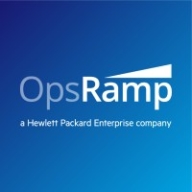

OpsRamp and Sumo Logic Observability are leading solutions in the IT management space. Pricing and support favor OpsRamp, while Sumo Logic Observability has the upper hand due to feature richness and user satisfaction.
Features:OpsRamp users value automation, integration capabilities, and ease of use. Sumo Logic Observability users highlight data analytics, real-time monitoring, and advanced analytical options.
Room for Improvement:OpsRamp users suggest improving scalability, customizability, and flexibility. Sumo Logic Observability users recommend enhancing alerting mechanisms, reducing noise, and adding more out-of-the-box integrations.
Ease of Deployment and Customer Service:Deployment is straightforward for OpsRamp, with some users citing setup as intuitive. Sumo Logic Observability offers easy setup and receives extra praise for comprehensive user support.
Pricing and ROI:OpsRamp is noted for competitive pricing and favorable ROI. Sumo Logic Observability has a higher cost, but users find the investment justified by its advanced features.
It is important to stick with available features and provide customers with clear, precise details about what can and cannot be done to avoid anomalies.
I find the licensing model convenient and clear enough, and I have seen a return on investment with OpsRamp.
Having a dedicated firefighter team for each MSP would be beneficial.
Technical support should be improved.
it does not strike me as expensive, and the licensing model is clear enough.
I have utilized OpsRamp's capability for predictive analytics, and it has been important in fostering collaboration between my IT and development teams under DevOps methodologies, where applicable.
| Product | Market Share (%) |
|---|---|
| OpsRamp | 7.0% |
| Sumo Logic Observability | 1.4% |
| Other | 91.6% |

| Company Size | Count |
|---|---|
| Small Business | 1 |
| Midsize Enterprise | 3 |
| Large Enterprise | 8 |
OpsRamp is a leading cloud-based digital IT operations management platform. The solution allows your organization to leverage hybrid observability, process automation, and machine learning to modernize IT operations. OpsRamp can handle the speed, scope, and scale of modern IT and can help you drive productivity and business value. In addition, it can help your business manage, monitor, and consolidate your point tools and applications.
OpsRamp Features
OpsRamp has many valuable key features. Some of the most useful ones include:
OpsRamp Benefits
There are many benefits to implementing OpsRamp. Some of the biggest advantages the solution offers include:
Sumo Logic Observability offers advanced monitoring solutions with features like integrated dashboards and querying capabilities, though presents a learning curve compared to alternatives. Designed for efficient log aggregation and analysis, it provides near-real-time updates facilitating improved incident resolution.
Sumo Logic Observability stands out with its ability to unify teams through a single platform, offering features that include customizable dashboards and valuable apps. It provides powerful log tracing and centralized management, designed for organizations focused on log aggregation, analysis, and expanding SIEM capabilities. While it has a steeper learning curve compared to some competitors, it excels in tailored integrations that enhance log searches. Users find themselves able to monitor, automate, and centralize log repositories for effective debugging. Despite its strengths, improvements in data enrichment and documentation organization are needed as current query functions can be slow, impacting efficiency. Users have also mentioned needing pre-built dashboards and better tab management for enhanced functionality. Cost management remains a notable consideration for users evaluating Sumo Logic Observability.
What features make Sumo Logic Observability effective?Sumo Logic Observability is implemented across industries predominantly for managing and analyzing extensive data sets, offering capabilities critical for SIEM activities and security examinations. By facilitating quick data visualization and transaction tracking, organizations in sectors such as finance, healthcare, and technology benefit from its robust framework to support infrastructure logging and large-scale data management, contributing to effective monitoring and system operations.
We monitor all AIOps reviews to prevent fraudulent reviews and keep review quality high. We do not post reviews by company employees or direct competitors. We validate each review for authenticity via cross-reference with LinkedIn, and personal follow-up with the reviewer when necessary.